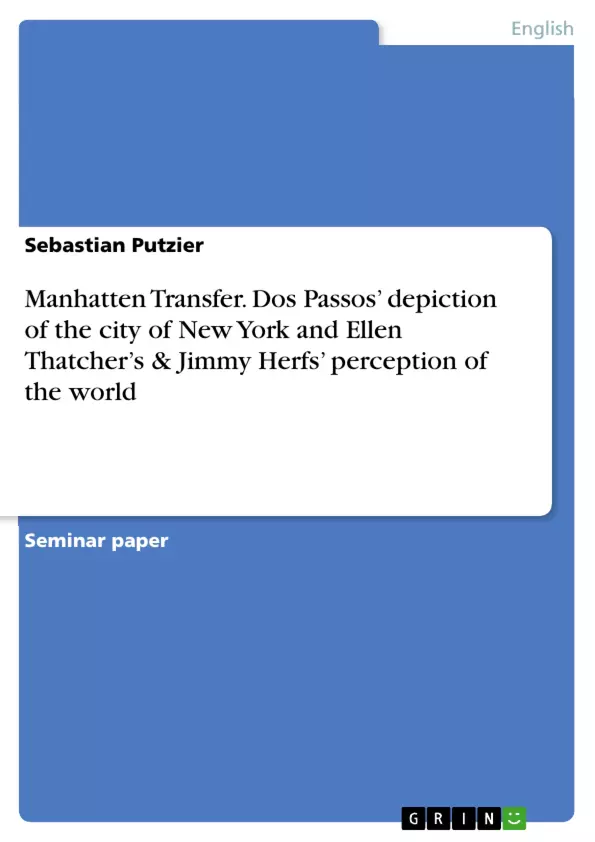Manhattan Transfer is one of the earliest of that type of novels which has come to be known as „collectivistic“. The idea is to present a cross-section of the social structure, the social organism; an “over-view” of the subject in which details of individual lives merge in the general picture of society” (Belkind 1971:61).
This quotation by Allen Belkind shows that the American author John Dos Passos is not interested in individual characters and their lives in Manhattan Transfer but in how the characters solve the problems and their everyday life in a metropolis, in the city of New York.
I would like to deal with Manhattan Transfer by John Dos Passos which was first published in 1925. I will start with some autobiographical facts about Dos Passos to show how he grew up and how his life influenced his works. A short summary and the numeration of stylistic features of Manhattan Transfer will lead to the depiction of the city New York as the actual protagonist of this novel. There are different social groups such as immigrants or poor and rich people described in the book. I want to deal with Ellen Thatcher and Jimmy Herf as the protagonists, and I want to show how they perceive the world. This part is the main topic of this paper. There are numerous essays about the novel Manhattan Transfer and how it deals with New York. I am going to point out the images of New York and their effects on Ellen Thatcher and Jimmy Herf.
John Rodrigo Dos Passos was born in Chicago/ Illinois on January 14th 1896. He studied at Harvard University and in Spain. He used the experiences he made as ambulance driver and medic in the Great War (1914-1918). For his first novel called One Man’s Initiation (1917). It was first published in 1920. His breakthrough came in 1921 with his second war novel Three Soldiers. In 1925, he published the most significant big town novel of Modernism: Manhattan Transfer. In this novel he portrays an extensive image of New York’s social classes between 1890 and 1925. In the paper Facing the Chair, Dos Passos fought for the anarchists Nicola Sacco and Bartolomeo Vanzetti who were executed after their political lawsuits. In his epochal masterpiece, USA, John Dos Passos raged in one "Camera Eye" episode:
Inhaltsverzeichnis (Table of Contents)
- Introduction
- 1. Content and Structure
- .1
- .3.
- 2. Historical Background
- 3. Depiction of New York
- 4. Ellen Thatcher
- 4.1 Smell
- 4.2 Noise
- 4.3 Optical Impressions
- 4.4 The sense of touch
- 4.5 Conclusion
- 5. Jimmy Herf
- 5.1 Smell
- 5.2 Noise
- 5.3 Optical Impressions
- 5.4 The sense of touch
- 5.5 Conclusion
- 6. Jimmy versus Ellen
Zielsetzung und Themenschwerpunkte (Objectives and Key Themes)
This paper aims to explore the city of New York as the central character in John Dos Passos' novel Manhattan Transfer. The paper examines the novel's depiction of the city's social landscape, focusing on the individual experiences of Ellen Thatcher and Jimmy Herf, and how they perceive the world through their senses.
- The portrayal of New York City as a dynamic and ever-changing metropolis
- The impact of social class and mobility on individual experiences
- The exploration of individual perception and sensory experiences in a complex urban environment
- The use of literary techniques to capture the fragmented and chaotic nature of city life
Zusammenfassung der Kapitel (Chapter Summaries)
The novel begins with the introduction of key characters like Ellen Thatcher, Bud Korpenning, and Jimmy Herf, and establishes their arrival in New York. The chapters delve into their individual lives, exploring their aspirations, struggles, and interactions within the city's social fabric. The novel portrays the city as a dynamic and diverse environment, showcasing its various social groups, economic dynamics, and cultural influences.
Schlüsselwörter (Keywords)
The novel explores themes of urban life, social mobility, individual perception, and sensory experience. Key concepts include the fragmented nature of city life, the impact of social class and mobility on individual experiences, and the use of sensory details to portray the dynamism and complexity of New York City.
- Arbeit zitieren
- Sebastian Putzier (Autor:in), 2007, Manhatten Transfer. Dos Passos’ depiction of the city of New York and Ellen Thatcher’s & Jimmy Herfs’ perception of the world, München, GRIN Verlag, https://www.hausarbeiten.de/document/84049


